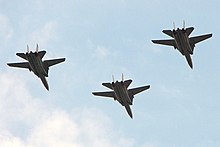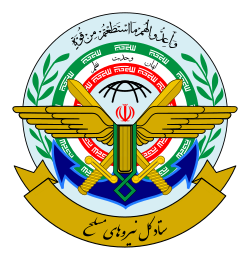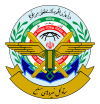Islamic Republic of Iran Armed Forces
The Armed Forces of the Islamic Republic of Iran (Template:Lang-fa) include the IRIA (ارتش جمهوری اسلامی ایران), the IRGC (سپاه پاسداران انقلاب اسلامی) and the Law Enforcement Force[4] (نيروی انتظامی جمهوری اسلامی ایران).
These forces total about 545,000 active personnel (not including the Law Enforcement Force).[5] All branches of armed forces fall under the command of General Headquarters of Armed Forces (ستاد کل نیروهای مسلح). The Ministry of Defense and Armed Forces Logistics is responsible for planning logistics and funding of the armed forces and is not involved with in-the-field military operational command.
History
When the Pahlavi dynasty took power in 1925, following years of war with Russia, the standing Persian army was almost non-existent. The new king Reza Shah Pahlavi, was quick to develop a new military. In part, this involved sending hundreds of officers to European and American military academies. It also involved having foreigners re-train the existing army within Iran. In this gap the Iranian Air Force was established and the foundation for a new Navy was laid.
Britain and the Soviet Union invaded Iran in 1941 in order to secure the area from German interventions. Following World War II, 1500 Iranian troops supported the Sultan of Oman against the Dhofar Rebellion from 1962–1975. In 1971, Iranian forces besieged Abu Musa and the Tunb islands. Before the Islamic revolution of 1979, Iran contributed to United Nations peacekeeping operations. Iran joined ONUC in the Congo in the 1960s, and ten years later, Iranian troops joined UNDOF on the Golan Heights.
With the Iranian revolution in 1979, deteriorating relations with the United States resulted in international sanctions led by the USA, including an arms embargo being imposed on Iran.
Revolutionary Iran was taken by surprise, by the Iraqi invasion that began the Iran–Iraq War of 1980–1988. During this conflict, there were several confrontations with the United States. From 1987, the United States Central Command sought to stop Iranian mine-laying vessels from blocking the international sea lanes through the Persian Gulf in Operation Prime Chance. The operation lasted until 1989. On April 18, 1988, the U.S. retaliated for the Iranian mining of the USS Samuel B. Roberts (FFG-58) in Operation Praying Mantis. Simultaneously, the Iranian armed forces had to learn to maintain and keep operational, their large stocks of U.S.-built equipment and weaponry without outside help, due to American sanctions. Reaching back on equipment purchased from the U.S.A. in the 1970s, the Iranians began establishing their own armaments industry; their efforts in this remained largely unrecognised internationally, until recently. However, Iran was able to obtain limited amounts of American-made armaments, when it was able to buy American spare parts and weaponry for its armed forces, during the Iran-Contra affair. At first, deliveries came via Israel and later, from the USA.
The Iranian government established a five-year rearmament program in 1989 to replace worn-out weaponry from the Iran-Iraq war. Iran spent $10 billion between 1989 and 1992 on arms. Iran ordered weapons designed to prevent other naval vessels from accessing the sea, including submarines and long-range Soviet planes capable of attacking aircraft carriers.[6]
A former military-associated police force, the Iranian Gendarmerie, was disbanded in 1990.
In 1991, the Iranian armed forces received a number of Iraqi aircraft fleeing from the Persian Gulf war of that year; most of which were incorporated into the Islamic Republic of Iran Air Force.
From 2003, there have been repeated U.S. and British allegations that Iranian forces have been covertly involved in the Iraq War. In 2007, Iranian Revolutionary Guard forces also took prisoner Royal Navy personnel when a boarding party from HMS Cornwall (F99) was seized in the waters between Iran and Iraq, in the Persian Gulf.
According to Juan Cole, Iran has never launched an "aggressive war" in modern history, and its leadership adheres to a doctrine of "no first strike".[7] The country's military budget is the lowest per capita in the Persian Gulf region besides the UAE.[7]
Since 1979, there are no foreign military bases present in Iran. According to Article 146 of the Iranian Constitution, the establishment of any foreign military base in the country is forbidden, even for peaceful purposes.[8]
Commanders
- Ayatollah Ali Khamenei (Supreme Leader and the Commander-in-Chief of the Armed Forces, in Persian: فرمانده کل قوا)
- Brigadier General Hossein Dehghan (سرتیپ پاسدار حسین دهقان) (Minister of Defence)
- Major General Seyed Hassan Firuzabadi (سرلشکر سید حسن فیروزآبادی)(Head of the Armed Forces General Command Headquarters, in Persian: رئیس ستاد کل نیروهای مسلح)
- Major General Yahya Rahim Safavi (سردار سرلشکر یحیی رحیم صفوی) (Senior Advisor to the Leader of the Islamic Revolution)[9]
- Islamic Republic of Iran Army
- Major General Ataollah Salehi (امیر سرلشکر عطاءالله صالحی)(Commander-in-Chief of the Army, in Persian: فرمانده کل ارتش)
- Brigadier General Mohammad Reza Ashtiani (امیر سرتیپ محمدرضا قرایی آشتیانی) (Deputy Chief of the Army)[10]
- Brigadier General Abdolrahim Mousavi (امیر سرتیپ عبدالرحیم موسوی) (Chief of the Joint Headquarter of the Army)
- Brigadier General Ahmad Reza Pourdastan (امیر سرتیپ احمدرضا پوردستان) (Commander of the Ground Force)
- Brigadier General Hassan Shahsafi (امیر سرتیپ حسن شاهصفی) (Commander of the Air Force)[11]
- Brigadier General Farzad Esmaili (امیر سرتیپ فرزاد اسماعیلی) (Commander of Air Defense Force)[12][13]
- Rear Admiral Habibollah Sayyari (امیر دریادار حبیبالله سیاری) (Commander of the Navy)
- IRGC
- Major General Mohammad Ali Jafari (سردار سرلشکر محمدعلی جعفری)(Commander-in-Chief of the IRGC, in Persian: فرمانده کل سپاه پاسداران)
- Brigadier General Hossein Salami (سرتیپ پاسدار حسین سلامی) (Chief of IRGC Air Force)[10]
- Brigadier General Mohammad Pakvar (سرتیپ پاسدار محمد پاکپور) (Commander of IRGC Ground Force)[14]
- Brigadier General Amir Ali Hajizadeh (سرتیپ پاسدار امیرعلی حاجیزاده) (Commander of IRGC Aerospace Force)[10]
- Rear Admiral Ali Fadavi (دریادار پاسدار علی فدوی) (Commander of IRGC Navy)[15]
- Major General Qasem Soleimani (سرلشکر پاسدار قاسم سلیمانی) (Commander of Quds Force)[16]
- Brigadier General Mohammad Reza Naghdi (سرتیپ پاسدار محمدرضا نقدی) (Commander of Basij forces)[10]
- Law Enforcement Force
- Brigadier General Esmaeil Ahmadi-Moghaddam (سرتیپ پاسدار اسماعیل احمدیمقدم) (Commander-in-Chief of the Law Enforcement Force, in Persian: فرمانده کل نیروی انتظامی)
Structure
- The Iranian armed forces consist of the Islamic Republic of Iran Army, Islamic Republic of Iran Navy,[17] Islamic Republic of Iran Air Force, and the Islamic Republic of Iran Air Defense Force. The regular armed forces have an estimated 425,000 personnel: the Islamic Republic of Iran Army, 350,000 personnel; the Islamic Republic of Iran Navy, 18,000 personnel, and the Islamic Republic of Iran Air Force, 52,000 airmen.[5] Islamic Republic of Iran Air Defense Force is a branch split off from the IRIAF.[18]
- The Army of the Guardians of the Islamic Revolution, or Revolutionary Guards, has an estimated 120,000 personnel in five branches: Its own Navy,[17] Aerospace Force, and Ground Forces; and the Quds Force (Special Forces).[5]
- The Basij is a paramilitary volunteer force controlled by the Islamic Revolutionary Guards. Its membership is a matter of controversy. Iranian sources claim a membership of 12.6 million, including women, of which perhaps 3 million are combat capable. There are a claimed 2,500 battalions of which some are full-time personnel.[19] GlobalSecurity.org quotes a 2005 study by the Center for Strategic and International Studies estimating 90,000 active-duty full-time uniformed members, 300,000 reservists, and a total of 11 million men that can be mobilized if need be.[20]
It has been reported that Iran is one of the five countries having a Cyber-army capable of conducting cyber-warfare operations. It has also been reported that Iran has immensely increased its cyberwarfare capability since the post presidential election un-rest.[21][22][23][24][25] Furthermore China has accused United States of having initiated a cyber war against Iran, through sites such as Twitter and YouTube and employing a hacker brigade for the purpose of fomenting unrest in Iran.[26][27] It has also been reported in early 2010, that two new garrisons for cyberwarfare have been established at Zanjan and Isfahan.[28]
Budget

Iran's 2007 defense budget was estimated to be $11.096 billion by SIPRI (2.5% of GDP). Per capita or percentage of GDP, this was a lower figure than for other Persian Gulf states.[2]
Defense industry




Under the last Shah of Iran, Mohammad Reza Pahlavi, Iran's military industry was limited to assembly of foreign weapons. In the assembly lines that were put up by American firms, such as Bell, Litton and Northrop, Iranian workers put together a variety of helicopters, aircraft, guided missiles, electronic components and tanks.[30] In 1973 the Iran Electronics Industries (IEI) was established.[31] The company was set up in a first attempt to organize the assembly and repair of foreign-delivered weapons.[32] The Iranian Defense Industries Organization was the first to succeed in taking a step into what could be called a military industry by reverse engineering Soviet RPG-7, BM-21, and SAM-7 missiles in 1979.[32]
Nevertheless, most of Iran's weapons before the Islamic revolution were imported from the United States and Europe. Between 1971 and 1975, the Shah went on a buying spree, ordering $8 billion in weapons from the United States alone. This alarmed the United States Congress, which strengthened a 1968 law on arms exports in 1976 and renamed it the Arms Export Control Act. Still, the United States continued to sell large amounts of weapons to Iran until the 1979 Islamic Revolution.[33]
After the Islamic revolution, Iran found itself severely isolated and lacking technological expertise. Because of economic sanctions and a weapons embargo put on Iran by the United States, it was forced to rely on its domestic arms industry for weapons and spare parts, since there were very few countries willing to do business with Iran.[34]
The Islamic Revolutionary Guards were put in charge of creating what is today known as the Iranian military industry. Under their command, Iran's military industry was enormously expanded, and with the Ministry of Defense pouring investment into the missile industry, Iran soon accumulated a vast arsenal of missiles.[30] Since 1992, it also has produced its own tanks, armored personnel carriers, radar systems, guided missiles, submarines, military vessels and fighter planes.[35][36]
In recent years, official announcements have highlighted the development of weapons such as the Fajr-3 (MIRV), Hoot, Kowsar, Fateh-110, Shahab-3 missile systems and a variety of unmanned aerial vehicles, at least one of which Israel claims has been used to spy on its territory.[37] In 2006, an Iranian UAV acquired and allegedly tracked the American aircraft carrier USS Ronald Reagan for 25 minutes without being detected, before returning safely to its base.[38]
On November 2, 2012, Iran's Brigadier General Hassan Seifi reported that the Iranian Army had achieved self-suffiency in producing military equipment, and that the abilities of Iranian scientists have enabled the country to make significant progress in this field. He was quoted saying, "Unlike Western countries which hide their new weapons and munitions from all, the Islamic Republic of Iran's Army is not afraid of displaying its latest military achievements and all countries must become aware of Iran's progress in producing weaponry."[39]
UAV program
Iran has produced several domestically developed unmanned aerial vehicle (UAV), which can be used for reconnaissance and combat operations. Iran have also captured US drones.
Ballistic program
On November 2, 2006, Iran fired unarmed missiles to begin 10 days of military simulations. Iranian state television reported "dozens of missiles were fired including Shahab-2 and Shahab-3 missiles. The missiles had ranges from 300 km to up to 2,000 km. Iranian experts have made some changes to Shahab-3 missiles installing cluster warheads in them with the capacity to carry 1,400 bombs." These launches come after some United States-led military exercises in the Persian Gulf on October 30, 2006, meant to train for blocking the transport of weapons of mass destruction.[40]
Iran is also believed to have started the development of an ICBM/IRBM missile project, known as Ghadr-110 with a range of 3000 km; the program believed to be a parallel of the advancement of a satellite launcher named IRIS.
Weapons of mass destruction
Iran ratified the Chemical Weapons Convention in 1997. Iranian troops and civilians suffered tens of thousands of casualties from Iraqi chemical weapons during the 1980-88 Iran–Iraq War. As a result, Iran has publicly stood against the use of chemical weapons, making numerous negative comments in international forums against Iraq's use of such weapons.[citation needed]
Even today, more than twenty-four years after the end of the Iran–Iraq War, about 30,000 Iranians are still suffering and dying from the effects of chemical weapons employed by Iraq during the war. The need to manage the treatment of such a large number of casualties has placed Iran’s medical specialists in the forefront of the development of effective treatment regimens for chemical weapons victims, and particularly for those suffering from exposure to mustard gas.[41]
Iran ratified the Biological Weapons Convention in 1973.[42] Iran has advanced biological and genetic engineering research programs supporting an industry that produces vaccines for both domestic use and export.[43]
Military aid to Syria & Hezbollah
In 2013, Iran was reported to supply money, equipment, technological expertise and unmanned aerial vehicles (a.k.a. 'drones') to Syria's Government and Lebanon's Hezbollah during the Syrian civil war.[44]
See also
- List of military equipment manufactured in Iran
- Equipment of the Iranian Army
- Current Iranian Navy vessels
- List of Iranian Air Force aircraft
- Rank insignia of the Iranian military
References
- ^ [1]
- ^ a b "SIPRI Publications". milexdata.sipri.org. Retrieved 15 January 2011. Select "Iran" and click "Submit"
- ^ "Iran, Belarus Sign Cooperation Agreements".
- ^ No Operation. Presstv.com. Retrieved on 2014-06-09.
- ^ a b c IISS Military Balance 2006, Routledge for the IISS, London, 2006, p.187
- ^ Pipes, Daniel; Patrick Clawson (1992/1993). "Ambitious Iran, Troubled Neighbors". Foreign Affairs. 72: 127. doi:10.2307/20045501.
{{cite journal}}: Check date values in:|year=(help)CS1 maint: year (link) - ^ a b Cole, Juan (2009-10-02). "The top ten things you didn't know about Iran: The assumptions most Americans hold about Iran and its policies are wrong". Salon.
- ^ "Russian Military Alliance With Iran Improbable Due To Diverging Interests". RFE/RL. Archived from the original on 18 September 2008. Retrieved 2008-09-16.
{{cite web}}: Unknown parameter|deadurl=ignored (|url-status=suggested) (help) - ^ No Operation. Presstv.com. Retrieved on 2014-06-09.
- ^ a b c d [2][dead link]
- ^ No Operation. Presstv.ir. Retrieved on 2014-06-09.
- ^ "Government creates 4th military arm: Air Defense". Iran Times International. February 20, 2009.[dead link]
- ^ "Apponitment of Farzaf Esmaili as commander of IRIADF". February 20, 2009.
- ^ "Appoitment of Mohammad Pakvar as commander of IRGC Ground Force". dolat.ir.
- ^ "Appoitment of Ali Fadavi as commander of IRGC Navy". Mehrnews.
- ^ Archived 2008-01-10 at the Wayback Machine. iranfocus.com. 4 August 2005
- ^ a b "The Consequences of a Strike on Iran: The Iranian Revolutionary Guard Corps Navy" Global Bearings, 15 December 2011.
- ^ "Air Defense Unit Added to Iran's Armed Forces". Farsnews. February 15, 2009.
- ^ IISS Military Balance 2008, p.244
- ^ GlobalSecurity.org. GlobalSecurity.org. Retrieved on 2014-06-09.
- ^ Leyne, Jon (2010-02-11). "How Iran's political battle is fought in cyberspace". BBC News. Retrieved 2010-02-13.
- ^ "Iran among 5 states with cyber warfare capabilities: US institute". Payvand.com. 2006-11-22. Retrieved 2010-02-13.
- ^ "Who's winning Iran's cyber-war?". Channel 4 News. 2009-06-16. Retrieved 2010-02-13.
- ^ "BBC فارسی - ايران - سایت رادیو زمانه هک شد". BBC News. Retrieved 2010-02-13.
- ^ Alka Marwaha (2009-06-24). "What rules apply in cyber-wars?". BBC News. Retrieved 2010-02-13.
- ^ Simon Tisdall (2010-02-03). "Cyber-warfare 'is growing threat'". London: The Guardian. Retrieved 2010-02-13.
- ^ "Beijing accuses U.S. of cyberwarfare". Washington Times. 2010-01-26. Retrieved 2010-02-13.
- ^ BBC فارسی - ايران - قرارگاه های 'جنگ نرم' در اصفهان و زنجان راه اندازی شد. Bbc.co.uk (1970-01-01). Retrieved on 2014-06-09.
- ^ "Iran set to unveil new submarine class". UPI. July 19, 2010.
- ^ a b Dar Al Hayat. Dar Al Hayat. Retrieved on 2014-06-09.
- ^ http://www.ieicorp.com/about.htm
- ^ a b NTI: Country Overviews: Iran: Missile Chronology
- ^ Archived 2006-03-08 at the Wayback Machine. cdi.org. May 22, 1994
- ^ Procurement: '''November 3, 2004'''. Strategypage.com (2004-11-03). Retrieved on 2014-06-09.
- ^ Iran Launches Production of Stealth Sub. FOXNews.com (2005-05-10). Retrieved on 2014-06-09.
- ^ PressTv: Advanced attack chopper joins Iran fleet Retrieved May 24, 2009
- ^ British Broadcasting Corporation, Hezbollah drone flies over Israel, 7 December 2004
- ^ Iranian drone plane buzzes U.S. aircraft carrier in Persian Gulf, May 30, 2006 and Iran Uses UAV To Watch US Aircraft Carrier On Gulf Patrol
- ^ Iran reports that Iran's Army has achieved self-suffiency in producing military equipment - Armyrecognition.com, November 5, 2012
- ^ Archived 2006-11-07 at the Wayback Machine
- ^ Archived 2008-06-09 at the Wayback Machine. Organisation for the Prohibition of Chemical Weapons. opcw.org
- ^ Signatories of the Biological Weapons Convention. Opbw.org. Retrieved on 2014-06-09.
- ^ "Razi Institute produces dlrs 100 m worth of vaccines, serums a year". Archived from the original on 19 April 2006. Retrieved 2006-04-22.
{{cite web}}: Unknown parameter|deadurl=ignored (|url-status=suggested) (help) - ^ Warrick, Joby (2013-06-02). "National Security". The Washington Post.
Further reading
- Template:Fr icon Alain Rodier, Template:PDF, French Centre for Research on Intelligence, January 2007 - Order of Battle, strategy, asymmetric warfare, intelligence services, state terrorism. Includes detailed order of battle for both regular army and Revolutionary Guard
- Anthony H. Cordesman, Iran's Military Forces in Transition: Conventional Threats and Weapons of Mass Destruction, Centre for Strategic and International Studies, ISBN 0-275-96529-5
- 'Iranian exercise reveals flaws in air defences,' Jane's Defence Weekly, 9 December 2009
- Kaveh Farrokh, Iran at War: 1500-1988, Osprey Hardcover, released May 24, 2011; ISBN 978-1-84603-491-6.
External links
- GlobalSecurity.org, Iranian armed forces
- Iran's Military: Strangely Powerful - slideshow by Life magazine
- Air University, Bibliography on Iran's military strategy
- The Gulf: Military Forces in an Era of Asymmetric War: Iran Center for Strategic and International Studies (2006)
- Iran & The Gulf Military Balance Center for Strategic and International Studies (2011)


